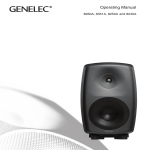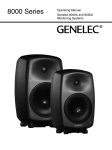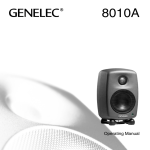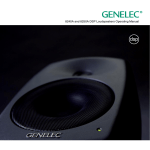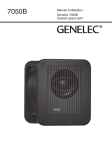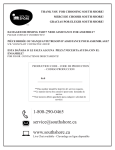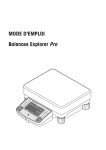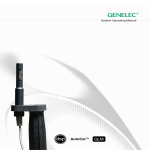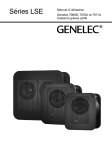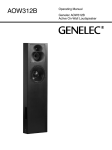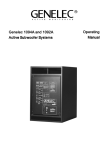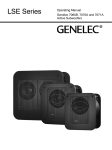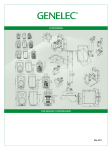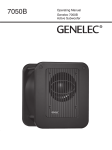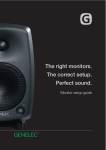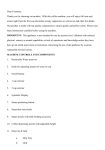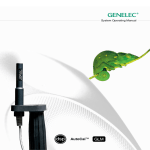Download 1238CF Operating Manual
Transcript
1238CF Operating Manual Genelec 1238CF DSP Loudspeaker Introduction the interference by one or more of the following measures: Congratulations and a thank-you for the purchase of this Genelec 1238CF DSP Loudspeaker. This loudspeaker is designed to integrate easily into the digital production environment. There are several ways to configure and operate the DSP loudspeaker for a wide variety of high quality audio applications. The 1238CF also has an analog input, making it a versatile and intelligent replacement for analog loudspeakers. • Reorient or relocate the receiving antenna. • Increase the separation between the equipment and receiver. • Connect the equipment into an outlet on a circuit different from that to which the receiver is connected. • Consult the dealer or an experienced radio/TV technician for help. This manual addresses setting up and using the 1238CF DSP loudspeaker in stand-alone mode without the Genelec Loudspeaker Manager GLM™ and the proprietary Genelec loudspeaker control network. Use with the GLM™ is described in the DSP System Operating Manual. Modifications not expressly approved by the manufacturer could void the user’s authority to operate the equipment under FCC rules. EC Declaration Of Conformity This is to certify that Genelec 1238CF DSP loudspeakers conform to the following standards: Safety: EN 60065: 2002 + A1: 2006 + A11:2008 / IEC 60065: 2001 7th Edition + A1: 2005 EMC: EN 55020: 2007, EN 55013: (2001) + A1: 2003 + A2: 2006 EN 61000-3-2 (2006) and EN 61000-3-3 (1995) + A1: 2001 + A2: 2005 The products herewith comply with the requirements of The Low Voltage Directive 2006/95/EC, EMC Directive 2004/108/EC and Energy related Products (ErP) Directive 2009/125/EC. Signed: Ilpo Martikainen Position: Chairman of the Board Date: 30-September-2010 Compliance to FCC Rules This device complies with part 15 of the FCC Rules. Operation is subject to the following two conditions: • This device may not cause harmful interference, and • This device must accept any interference received, including interference that may cause undesired operation. Note: This equipment has been tested and found to comply with the limits for a Class B digital device, pursuant to part 15 of the FCC Rules. These limits are designed to provide reasonable protection against harmful interference in a residential installation. This equipment generates, uses and can radiate radio frequency energy and, if not installed and used in accordance with the instructions, may cause harmful interference to radio communications. However, there is no guarantee that interference will not occur in a particular installation. If this equipment does cause harmful interference to radio or television reception, which can be determined by turning the equipment off and on, the user is encouraged to try to correct 2 Safety Considerations Although the 1238CF has been designed in accordance with international safety standards, to ensure safe operation and to maintain the loudspeaker under safe operating conditions, the following warnings and precautions must be observed: • Servicing and adjustment must only be performed by qualified service personnel. The loudspeaker enclosure must not be opened. • Do not use this product with an unearthed mains cable or a mains connection without the protective earth contact as this may lead to personal injury. • To prevent fire or electric shock, do not expose the unit to water or moisture. • Do not place any objects filled with liquid, such as vases on the loudspeaker or near it. • Note that the amplifier is not completely disconnected from the AC mains service unless the mains power cord is removed from the amplifier or the mains outlet. • Free flow of air behind the loudspeaker is necessary to maintain sufficient cooling. • Do not obstruct airflow around the loudspeakers. • Note that the amplifier is not completely disconnected from the AC mains service unless the mains power cord is removed from the amplifier or the mains outlet. WARNING! The Genelec 1238CF loudspeaker is capable of producing sound pressure levels in excess of 85 dB, which may cause permanent hearing damage. System The Genelec 1238CF DSP Loudspeaker is designed for precise monitoring of 24 bit/192 kHz AES/EBU digital audio signal or line level analog audio signal. The 1238CF is fully compatible with Genelec Loudspeaker Manager GLM™ and the proprietary Genelec loudspeaker control network and Genelec 7271A DSP Active Subwoofer, but can also be used independently of these. The 1238CF features high SPL output and low colouration in MAINS POWER SWITCH -8 1 ON OFF 2 ON OFF -12 GLM CONTROL NETWORK CONNECTORS SWITCH 1 BASS ROLL-OFF BASS TILT -2 dB -4 dB -2 dB -4 dB -6 dB DESKTOP -4 dB 160 Hz -6 dB TREBLE TILT ON OFF 0 dB STORED AES/EBU CH. DRIVER MUTE WF COAX A B SYSTEM LVL. -10 -20 SWITCH 2 -30 dB +2 dB -4 dB -2 dB STAND-ALONE USER INTERFACE LEVEL CONTROL -6 -4 -2 -10 MANUAL CTRL ON + ON OFF + OFF SUM A AND B STAND-ALONE USER INTERFACE SWITCH GROUPS 1 AND 2 ANALOG INPUT CONNECTOR MAINS INPUT 230 V~ 50 / 60 Hz 330 W SERIAL NUMBER 12 V REMOTE DIGITAL IN AES/EBU DIGITAL THRU AES/EBU ANALOG IN 1238CF DSP TRI-AMPLIFIED MONITORING SYSTEM MAGNETICALLY SHIELDED www.genelec.com MADE IN FINLAND DIGITAL THRU CONNECTOR 292-1238T-6 MAINS INPUT CONNECTOR 12V REMOTE CONNECTOR a small enclosure size. It is suitable for a wide variety of tasks, such as near field monitoring, mobile vans, broadcast and TV control rooms, surround sound systems and home studios. The advanced Directivity Control Waveguide™ (DCW™) technology provide excellent frequency balance even in difficult acoustic environments. Amplifiers The amplifier unit is mounted in the rear of the loudspeaker enclosure. The unit incorporates special circuitry for driver thermal overload protection. Variable input sensitivity allows accurate level matching to console output section. Using the Loudspeakers in Stand-Alone Mode The 1238CF accepts both analogue line level input signals and AES/EBU formatted digital input signals. When the loudspeakers are not connected to a Genelec loudspeaker control network, they operate in stand-alone mode. However, settings made with the Genelec Loudspeaker Manager software can be saved into each loudspeaker and applied even when the network is disconnected by setting switch 1 “STORED/ MANUAL CONTROL” on switch group 2 of each loudspeaker to position “STORED.” This manual concentrates on using the loudspeakers without the control network. All issues concerning use with the network are explained in detail in the System Operating Manual provided with the GLM™ Loudspeaker Manager software kit. Connections DIGITAL INPUT CONNECTOR Figure 1. Connectors and controls on the back panel of the 1238CF. network cable and an operating manual. Before connecting up, ensure that the mains switch is off. “MAINS INPUT” Connector Connect the mains supply to this connector. “DIGITAL IN AES/EBU” Connector Use this female XLR connector for AES/EBU formatted digital audio input signals. This input is selected automatically when a valid digital audio signal is present, and overrides the analogue input. Depending on the digital hardware, transmission of a 192 kHz sample rate is achieved using a double speed, single channel/ cable interface. This is called dual-wire mode. In this case one cable per channel is used and no channel selection is required. Dual-wire mode is automatically detected by the input stage. If the digital source device has a digital level monitor pot or graphical volume fader that controls the digital level, it may be advantageous to lower the level control either on the GLM software interface or the loudspeaker’s back panel controls rather than the source device, which in turn will force the use of more of the digital [bit] resolution in the volume control. If the digital input is used, audio levels are referenced to 0 dBFS (digital Full Scale, the largest level that may be represented in the AES/EBU signal). Genelec DSP loudspeakers produce 100 dB SPL at 1 meter in free space for a digital input signal of –30 dB FS. It is advantageous to keep the digital level as high as possible. “DIGITAL THRU AES/EBU” Connector This male XLR carries an unaltered copy of the digital signal fed into the “DIGITAL IN AES/EBU” connector. It can be used for daisy-chaining up to four loudspeakers together. Each loudspeaker is supplied with a mains cable, one 5 m GLM 3 “ANALOG IN” Connector 235 mm 9 1/4” Use this connector for analog audio signals. When operating an 1238CF in the analog mode the A/D converter must not be overloaded, otherwise distortion will be heard. The maximum input level is +22.0 dBu RMS. When A/D converter input clip occurs the front panel light turns momentarily red, indicating the overload condition. If the “Level” control on the back panel is reduced (turned counter-clockwise), the acoustic output will be reduced. This control decreases the output from the D/A converters. Ideally the Level control should be set to force the use of more of the input range of the A/D converter without overloading it. Remember, there is no headroom above the maximum input to the A/D conversion. “CONTROL NETWORK” Connectors Use these RJ-45 sockets to connect the loudspeaker to the proprietary Genelec Loudspeaker Manager™ (GLM™) network only. This connector is not Ethernet LAN compatible. Do not connect to Ethernet LAN. “12 V REMOTE” Connector You can set up remote controlled powering up and down of the 1238CF with 12 V 60 mA trigger voltage connected to this connector. Front Panel Warning Light Normally the light on the front panel of a 1238CF loudspeaker is green, indicating that the loudspeaker is in normal operational mode. The overload light (red) is activated by several events, • exceeding the maximum input range of the analog input • exceeding the maximum input range of the digital input with large probability • exceeding the output capacity of the power amplifier (clipping in the power amplifier) and thermal overload of the power amplifier or loudspeaker drivers (thermal protection has activated) • if an error is detected in the AES/EBU audio data If a red warning light appears, turn the source down! If the levels are already modest and a digital signal is being used, ensure that there are no bit errors in the AES/EBU digital audio data. Mounting Considerations Align the Loudspeakers Correctly Always place the loudspeakers so that their acoustic axes are aimed towards the listening position (see Figure 2). Vertical placement is mandatory to maintain cooling behind the loudspeaker. 4 CLIP PROTECT (FAULT) READY 456 mm 17 15/16” a Figure 2. The location of the acoustic axis is on the centerline of the enclosure at the given height. Maintain Symmetry Check that the loudspeakers are placed symmetrically and at an equal distance from the listening position. If possible, place the system so that the listening position is on the centerline of the room and the loudspeakers are placed at an equal distance from the centerline. Minimise Reflections Acoustic reflections from objects close to the loudspeakers like desks, cabinets, computer monitors etc. can cause unwanted colouration and blurring of the sound image. These can be minimised by placing the loudspeaker clear of reflective surfaces. For instance, putting the loudspeakers on stands behind and above the mixing console usually gives a better result than placing them on the meter bridge. Symmetrical positioning of the reflective objects is also importent in order to maintain a balanced soundstage. Minimum Clearances Sufficient cooling for the integrated amplifier must be ensured if the loudspeaker is installed in a restricted space such as a cabinet, or integrated into a wall structure. The surroundings of the loudspeaker must always be open to the listening room with a minimum clearance of 5 centimeters (2”) behind, above and on both sides of the loudspeaker. The space adjacent to the loudspeaker must either be ventilated or sufficiently large to dissipate heat so that the ambient temperature does not rise above 35 degrees Celsius (95°F). Setting the Input Sensitivity The loudspeaker level sensitivity functions for both analog and digital input. The sensitivity can be matched by adjusting the rotary Level control together with the System Level switches lo- cated in the switch group 2. (switches 6 and 7). The switches provide attenuation levels of -10 dB (sw. 6 ON), -20 dB (sw. 7 ON) and -30 dB (both switches ON) The combined attenuation ranges from 0 to -42 dB. Functions On Switch Group 1 (Tone Controls) Switch group 1 (the upper switch group) comprises the tone controls that can be used to adjust the frequency response of the system in stand-alone mode to match the acoustic environment. Please note that the GLM Loudspeaker Controller allows a much more versatile and precise set of controls to be used and supports the fully automatic system alignment feature, Genelec AutoCal. Use the tone control switches on the loudspeaker only if a GLM is not available for for calibrating the system. The controls are labelled “TREBLE TILT”, “BASS TILT”, “BASS ROLL-OFF” and “DESKTOP”. The factory settings for these controls are all “OFF” to give a flat anechoic response. Note that these controls have no effect when switch 1 “STORED/MANUAL CONTROL” on switch group 2 is set to “STORED” or when the loudspeaker is connected to the Genelec loudspeaker control network. Bass Roll-Off Control Bass Roll-Off control (switches 1 and 2) affects the low frequency roll-off of the loudspeaker and attenuates its output near the cutoff frequency. Attenuation levels of -2 dB (sw. 1 ON), -4 dB (sw. 2 ON) or -6 dB (both switches ON) can be selected. Bass Tilt Control The Bass Tilt control switches (swiches 3 and 4) offer three attenuation levels for the bass response below 800 Hz, usually necessary when the loudspeakers are placed near room boundaries. The attenuation levels are -2 dB, -4 dB and -6 dB. Desktop Low Frequency Control The desktop low frequency control (switch 5) attenuates the bass frequencies around 160 Hz by 4 dB. This feature is designed to compensate for the boost often occurring at this frequency range when the loudspeaker is placed upon a meter bridge, table or similar reflective surface. Treble Tilt Control Treble Tilt control (switches 6 and 7) allows adjusting the treble response above 5 kHz by +2 dB, -2 dB or -4 dB, which can be used for correcting an excessively bright or dull sounding system or to compensate for high frequency level loss if the loudspeaker is placed behind a screen. An acoustic measuring system such as WinMLS is recommended for analyzing the effects of the adjustments, however, careful listening with suitable test recordings can also lead to good results if a test system is not available. Table 1 shows some typical settings in various situations. Loudspeaker Mounting Position Treble Tilt Bass Tilt Bass Roll-Off Desktop Flat anechoic response None None None None Free standing in a damped room None -2 dB None None Free standing in a reverberant room None -4 dB None None Near field on a reflective surface None -2 dB None -4 dB In a corner None -4 dB -4 dB None Table 1. Suggested Tone Control settings in some typical situations. Always start adjustment by setting all switches to “OFF” position. Measure or listen systematically through the different combinations of settings to find the best frequency balance. See Table 1 for some typical settings in various situations. Functions On Switch Group 2 Stored / Manual Ctrl This allows the selection between two basic methods of controlling the loudspeaker in the stand-alone mode. “MANUAL CTRL” refers to controlling the loudspeaker using the controls on the loudspeaker’s back panel. The “STORED” refers to using settings stored inside the memory of the loudspeaker. These settings are made using GLM and the GLM Control Network. There is additional functionality compared to that offered by the room response correction switches on the back panel. AES/EBU CH This selects the audio channel(s) available on the AES/EBU cable to be reproduced by the loudspeaker. Turning both switches on reproduces the sum of the two channels on the AES/EBU cable. Turning both switches off has the same effect which has been done deliberately to avoid the situation where no input channel is selected and the loudspeaker is effectively muted. When two channels are selected, 6 dB of attenuation is automatically applied to avoid overloading the loudspeaker. If the AES/EBU cable is operated in dual-wire mode (typically 192 kHz sampling frequency) one AES/EBU cable carries only one audio channel. The loudspeaker detects this situation automatically and the channel selection switches have no effect. Driver Mute These two switches allow you to mute the treble and midrange drivers (marking DCW) or bass driver (marking “WF”) independently. This may be useful to diagnose if a transducer is faulty. System Lvl These switches allow scaling down of the loudspeaker output. The signal sent to the “Thru” output connector is not affected. The switches are additive, for example, “–30 dB” attenuation is 5 achieved by turning on the “–10 dB” and “–20 dB” switches. The effect of these switches is combined with the effect of the rotary level adjustment control. This results in total possible attenuation of 42 dB, 30 dB by the system level switches and another 12 dB by the rotary control. Using 7000 Series Analog Subwoofers with the 1238CF DSP Loudspeakers Genelec recommend the use of DSP subwoofers (7200 Series) with DSP loudspeakers. However, it is also possible to use analog subwoofers. Please follow the steps below to integrate an analog subwoofer into a system of DSP loudspeakers: • Connect cables carrying analog audio to the 7000 Series analogue subwoofer first. • Connect the subwoofer outputs to the analog inputs of the 1238CF DSP loudspeakers. • Connect the GLM Control Network to the loudspeakers. • Make a System Setup in GLM. It will consist of only loudspeakers as this is all the network can see, so suitable Rapid Cabling Presets are “Stereo Pair (Analog)” and “5.0 Surround System (Analog)”. • Run AutoCal and review and the results to check for large dips at or above 85 Hz. Move the loudspeakers and repeat AutoCal if there is a problem. • Press “Finish”, then in the Main Page select “Menu | Store Acoustic Settings to All Online Loudspeakers” and close GLM. • For each DSP loudspeaker, turn it off, select “Stored” on the back of each loudspeaker to enable the internal Acoustic Settings, and then turn it on again. • To set the phase control on the subwoofer, connect the Center channel output of the subwoofer to the loudspeaker to be used to align phase. • Follow the instructions in the subwoofer user manual for setting phase and level. Genelec Oy 1238CF (dBr) vs freq (Hz) 3 Mar 11 100 95 d B r A 90 0° 15° 85 80 75 30° 45° 60° 70 65 60 55 50 20 100 50 200 500 1k 5k 2k 20k 10k Hz Figure 3: The upper curve group shows the horizontal directivity characteristics of the 1238CF measured at 1 m. The lower curve shows the systems power response. Genelec Oy 1238CF d B r A (dBr) vs freq (Hz) 3 Mar 11 90 85 DESKTOP LF 90 80 85 80 90 BASS TILT 85 80 TREBLE TILT BASS ROLL-OFF 20 50 100 200 500 1k 2k 5k 20k 10k Hz Maintenance No user serviceable parts are to be found within the loudspeaker enclosure. Any maintenance or repair of the loudspeaker should only be undertaken by qualified service personnel. Guarantee The Genelec 1238CF is supplied with two year guarantee against manufacturing faults or defects that might alter the performance of the loudspeakers. Refer to supplier for full sales and guarantee terms. Accessories A wide selection of accessories is available for Genelec loudspeakers. Consult the Accessories Catalogue on www.genelec. com or your local distributor/dealer for up-to-date information. 6 Figure 4: The curves above show the effect of the “bass tilt”, “treble tilt” , “desktop” and “bass roll-off” controls on the free field response. Figure 5: Horizontal directivity of the 1238CF. Figure 4: Vertical directivity of the 1238CF. system specifications Amplifier Section 1238CF Lower cut-off frequency, –3 dB < 55 Hz Upper cut-off frequency, –3 dB > 20 kHz Free field frequency response 57 Hz – 20 kHz (± 2.0 dB) Maximum short term sine wave acoustic output on axis in half space, averaged from 100 Hz to 3 kHz @ 1 m > 117 dB SPL Maximum long term RMS acoustic output in same conditions with IEC weighted noise (limited by driver unit protection circuit @ 1 m > 107 dB SPL Maximum peak acoustic output per pair with music material @ 2 m > 124 dB Self generated noise level in half space at 1 m on axis (A-weighted) < 15 dB Harmonic distortion at 90 dB SPL at 1 m on axis Freq: 60…100 Hz > 100 Hz Drivers Bass Midrange Treble <1% < 0.5 % 2 x 210 mm (8") cone 125 mm (5”) cone 25 mm (1") metal dome All drivers are magnetically shielded Weight 42 kg (93 lb) Dimensions Height Width Depth 610 mm (24”) 470 mm (181/2”) 257 mm (101/8”) 1238CF Bass amplifier short term output power Midrange amplifier short term output power Treble amplifier short term output power 150 W at 4 Ohm load 120 W at 8 Ohm load 120 W at 8 Ohm load Long term output power is limited by driver unit protection circuitry Slew rate 80 V/us Amplifier system THD at nominal output < 0.05 % Signal to Noise ratio, referred to full output Bass Midrange Treble >100 dB >100 dB >100 dB Mains voltage Mains voltage operating range 100/200 or 115/230 V -10 to +10 % Power consumption (average) Idle Full output 23 VA 330 VA SIGNAL PROCESSING Section 1238CF Digital signal input connector XLR female 110 kOhm AES/EBU Single Wire or Dual Wire Digital signal output / Thru connector XLR male 110 kOhm AES/EBU Single Wire or Dual Wire Analog signal input connector XLR female, balanced 10 kOhm pin 1 gnd, pin 2 +, pin 3 - Digital audio Word length Sample rate 16 - 24 bits 32 - 192 kHz Control network Type Connection Proprietary GLM™ network 2 RJ45, CAT5 cables Crossover frequency Bass/Mid Mid/Treble 420 Hz 2.8 kHz GLMTM software frequency response adjustment * Notch filters Shelving filters 4 LF and 2 HF 2 LF and 2 HF System calibration Auto Cal™, Stand-alone * The notch and shelving filters adjustments, AutoCalTM and GLMTM manual system calibration features are part of the Genelec Loudspeaker Manager (GLMTM) software 7 1238CF Operating Manual www.genelec.com Genelec Document D0100R001 Copyright Genelec Oy 10.2010. All data subject to change without prior notice International enquiries: In the U.S. please contact: In Sweden please contact: In China please contact: Genelec, Olvitie 5 Genelec, Inc., 7 Tech Circle Genelec Sverige Beijing Genelec Audio Co.Ltd FIN-74100, Iisalmi, Finland Natick, MA 01760, USA Ellipsvägen 10B Jianwai SOHO, Tower 12, Phone +358 17 83881 Phone +1 508 652 0900 P.O. Box 5521, S-141 05 Huddinge Room 2605 Fax +358 17 812 267 Fax +1 508 652 0909 Phone +46 8 449 5220 D-1504, Chaoyang District Email [email protected] Email [email protected] Fax +46 8 708 7071 Beijing 100022, China Email [email protected] Phone +86 10 8580 2180 Fax +86 10 8580 2181 Email [email protected]








